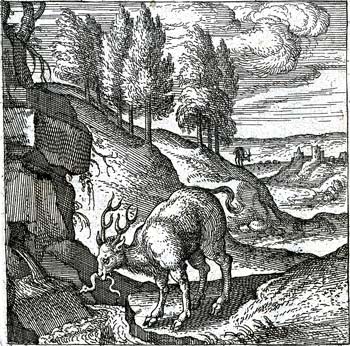Quoting Psalm 41, the Physiologus says that the stag "longs for flowing streams." The stag is the enemy of the serpent (some versions say "dragon"); when the serpent flees into cracks in the earth, the stag drinks from a stream and spits the water into the crack, driving out the serpent. The stag then stamps on the serpent, killing it. This is interpreted as meaning that Christ killed the serpent (the devil) with the waters of heavenly words of wisdom.
The Epiphanius version is different, adding attributes found more commonly in the 13th century bestiaries than in the Physiologus. It says that the stag (or deer) is similar to a "goat of the woods"; its horn has three branches, and it can three times renew its life. It lives for 50 years in the forest, on mountains, and in valleys, and runs swiftly all over. If it smells a serpent in a crevice or detects one by smell hiding anywhere, it at once draws the serpent out with the breath of its nostrils and eats it. The venom of the serpent burns the stag, which quickly goes to a spring to drink; if it does not do so within three hours it will die, but if it does, it will renew its life for another 50 years. The interpretation says that the spiritual man has three ways to redemption: baptism, grace and penance. The serpent is sin, which through grace is washed away by baptism.
The stag in the van der Borcht copperplate engraving below has caught a serpent and is eating it. The stream can be seen at the lower left; the stag is in a valley in the mountains. The stag's horns are more realistic than those in the earlier woodcut, and have the required three branches.
The woodcut below (from the Rome, 1577 edition) also shows the stag eating a serpent near a stream, but its horns have more than three branches.


